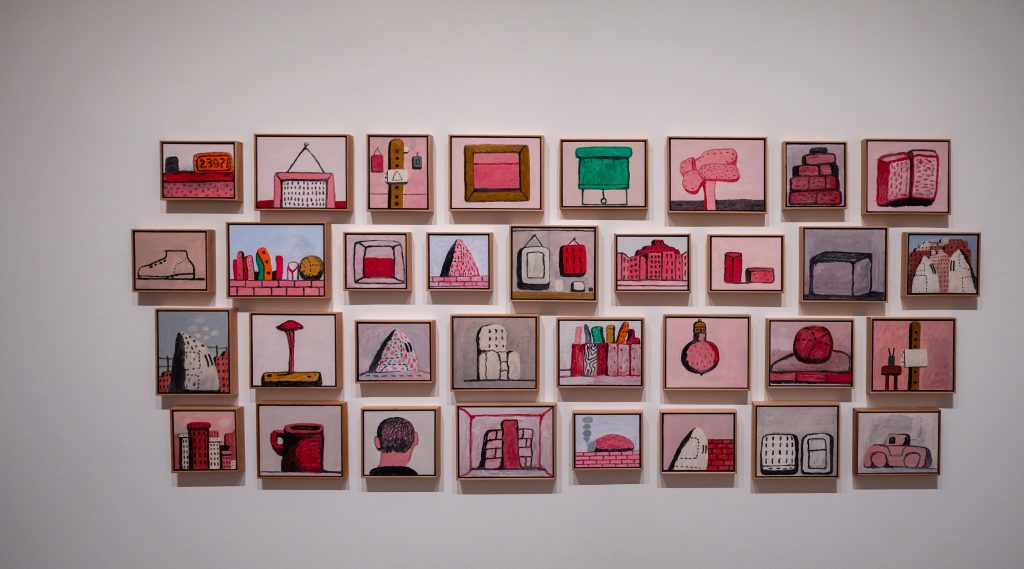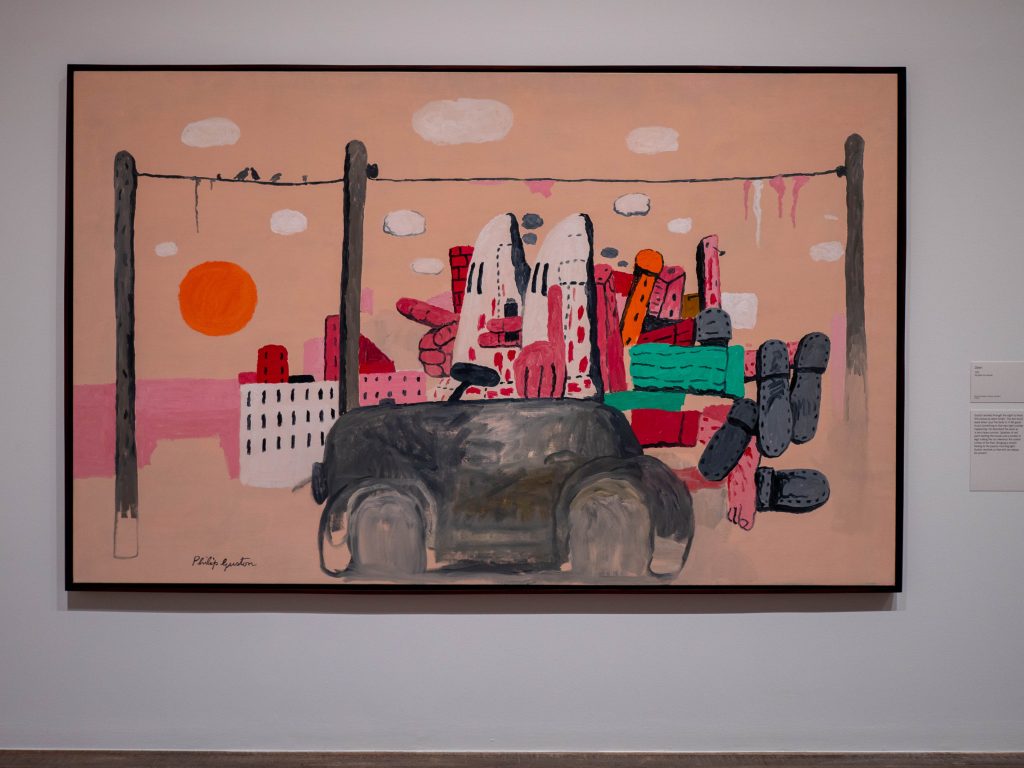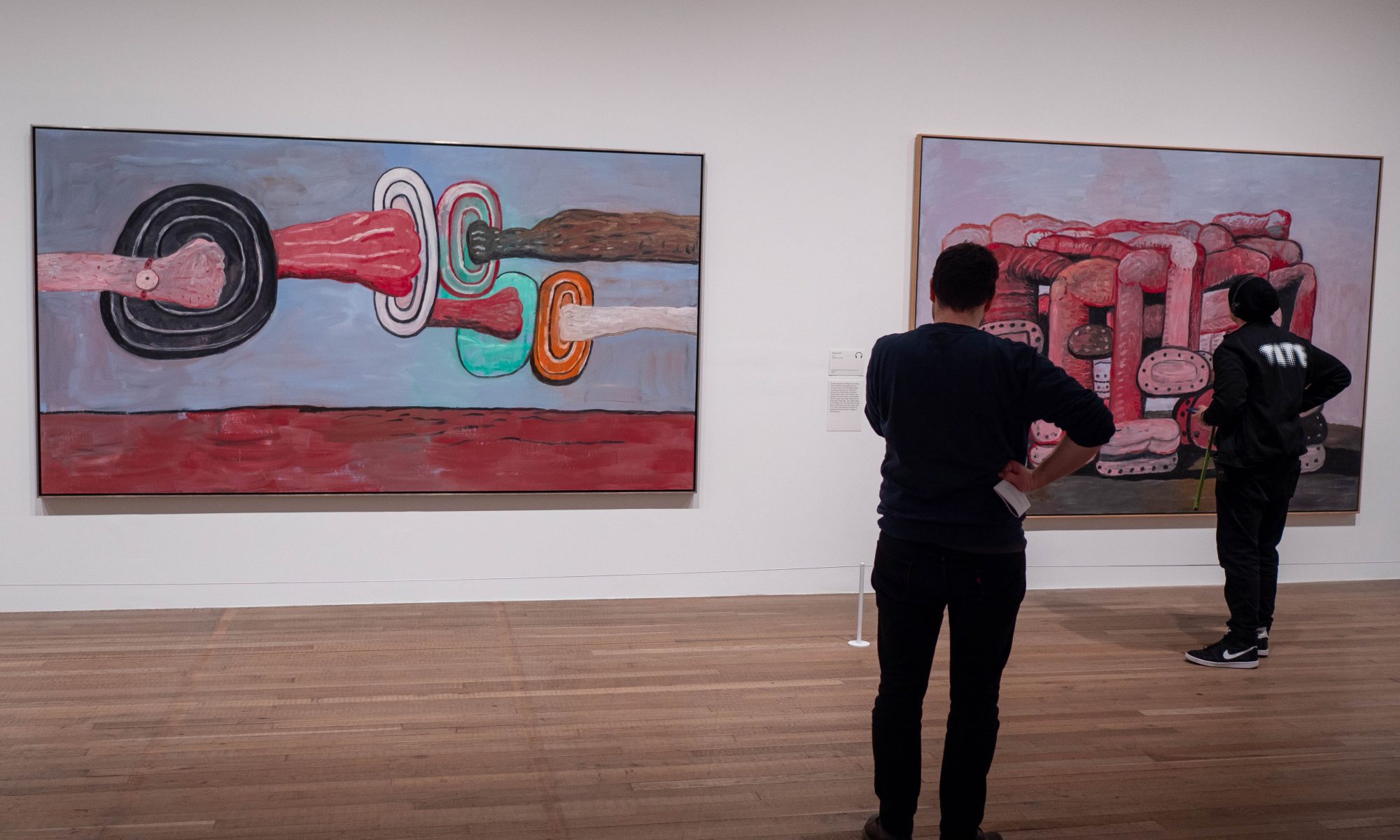This essay situates Philip Guston’s late "grotesque" paintings within the tradition of political cartooning exemplified by William Gropper and inspired by Francisco Goya. It argues that Guston’s cartoon-like style is a deliberate, urgent form of moral and political critique—not a simple borrowing from popular comics—using satire and caricature to confront social and personal trauma.
When Philip Guston unveiled the paintings that would redefine his late career at the Marlborough Gallery in 1970, the art world was jolted by their raw, cartoonish figuration: hooded Klansmen, bloodied shoes, clocks, and cigarettes rendered with thick, clumsy brushstrokes and heavy outlines. Early responses often framed these works as a stylistic flirtation with popular culture cartoons, invoking influences such as Krazy Kat or underground comics. This reading, however, risks obscuring the deeper, more politically charged lineage from which Guston’s grotesque imagery arises—a lineage traceable not to entertainment cartoons, but to the radical activist cartoons of artists such as William Gropper and the broader tradition of social realism and political satire.
This political dimension of Guston’s late imagery is often overshadowed by formalist interpretations that emphasize its cartoonish appearance while neglecting its moral intent. Unlike popular comic strips designed primarily for entertainment, Guston’s grotesque figures serve as urgent symbols of historical and ongoing violence, racial terror, and personal complicity. This approach finds a clear antecedent in William Gropper’s activist cartoons, which similarly deploy caricature and grotesque distortion to lay bare the machinery of oppression. Both artists harness the visual language of “cartoons” not to amuse but to provoke critical reflection, aligning their work with a tradition of political satire that stretches back to Goya and beyond.

William Gropper, a generation senior to Guston and a committed social realist, produced a sustained body of work that fused biting political commentary with grotesque caricature. His Caprichos series, created between 1953 and 1956, directly referenced Goya’s iconic Los Caprichos etchings, translating the Spanish master’s moral indictments into a mid-twentieth-century American context of political activism, McCarthyism, and political repression. These works employ distorted hybrid figures and exaggerated forms not for humour’s sake but as powerful symbols of political resistance against the paranoia and repression of the McCarthy era. Gropper’s cartoons functioned not as mere entertainment but as urgent visual manifestos exposing systemic injustice and social hypocrisy.
William Gropper was blacklisted during the McCarthy era, a time when fear-mongering and political opportunism fueled a witch hunt against leftist artists and intellectuals. McCarthy’s campaign weaponized paranoia to enforce conformity and suppress dissent, effectively silencing voices like Gropper’s that challenged the status quo. This blacklisting was less about national security and more about maintaining ideological control through intimidation and censorship.
This intersection of grotesque imagery and political engagement characterizes both artists’ approach to figuration as a form of social critique. Where Guston’s late paintings shocked audiences with their crude, almost childlike simplicity, they shared with Gropper’s work a profound commitment to exposing systems of oppression through symbolic exaggeration and satirical distortion. Both artists deliberately embraced a visual vocabulary that destabilizes traditional notions of beauty and decorum, using caricature not as escapism but as a means to confront and unsettle. This common ground reveals that Guston’s “cartoonish” style is not a descent into frivolity but a strategic reclaiming of political cartooning’s power to articulate moral outrage and historical reckoning.

Guston’s late paintings align formally and conceptually with this activist cartoon tradition. His return to figuration was no retreat into nostalgia or irony but a deliberate strategy to confront America’s unresolved legacies of racism, violence, and moral failure. The hooded figures that populate works such as The Studio (1969) and City Limits (1970) function as grotesque archetypes of evil and complicity. Guston’s thick brushwork, rough-edged forms, and lurid palette deny the viewer aesthetic comfort, demanding engagement with uncomfortable truths. While the flattened perspective and graphic contours recall comic strips, Guston’s purpose is not to entertain but to indict, much as Gropper’s caricatures do.

This alignment is not merely stylistic but profoundly ideological and deeply personal. Guston’s embrace of figuration serves as a means to wrestle not only with the historical and cultural traumas embedded in American society—particularly the persistence of racial violence and complicity—but also with his own personal and familial struggles, including his Jewish heritage and the weight of inherited trauma. Rejecting the detachment of abstract art, Guston, like Gropper, who used his art to confront the abuses of power during the McCarthy era, reclaims the visual language of caricature and satire as a vehicle for moral urgency. Their shared commitment to grotesque exaggeration is less about distortion for its own sake and more about amplifying the ethical dimensions of their subjects, forcing viewers into uncomfortable recognition of societal and personal ills.
The connection deepens through their shared invocation of Goya. Guston often cited Goya as a profound influence, praising the Spanish master’s capacity to merge personal anguish with social critique (Ashton, 1976). Gropper’s explicit homage through his Caprichos series situates him firmly within this lineage. Both artists inherit a visual vocabulary of the grotesque and the satirical, deploying it to expose political and moral corruption in their respective times.
This shared invocation of Goya underscores a mutual commitment to art as a form of urgent social testimony. Both Guston and Gropper channel Goya’s capacity to intertwine the intimate with the political, using grotesque and satirical imagery to confront human cruelty and systemic injustice. Their work transcends mere formal experimentation; it embodies a moral imperative to bear witness and to unsettle complacency. In doing so, they reclaim the figure and the cartoon as potent tools of resistance, breaking through the distance often imposed by modernist abstraction to engage viewers directly in ethical reflection.
The comparison between Guston and Gropper reveals a shared refusal of modernist abstraction’s detachment and formalism. Instead, they embrace a raw, accessible visual language that blends humour and horror, caricature and confession, in the service of political engagement. Guston’s late work, often dismissed as derivative of popular cartoons, emerges as a continuation and deepening of the radical activist cartooning exemplified by Gropper. This insight challenges reductive readings and restores the vital political function of Guston’s art.
By positioning Guston’s late paintings within the lineage of activist cartooning, we recognize that his stylistic shift was not a mere aesthetic choice but a deliberate political act. His use of crude, cartoonish forms channels a tradition of social critique that demands attention and discomfort, rather than passive consumption. This approach foregrounds the artist’s role as moral witness and provocateur, challenging the viewer to confront the insidious realities of racism, violence, and complicity. In doing so, Guston reclaims the power of the grotesque and the satirical as vital instruments in the ongoing struggle for justice.
Understanding Guston through this prism enriches our appreciation not only of his aesthetic innovations but also of the ethical urgency underpinning his late paintings. It situates him within a tradition of artists for whom cartoonish imagery is never neutral but a charged, confrontational tool—one that mobilizes distortion and satire to wake viewers from complacency. Both Guston and Gropper remind us that the grotesque cartoon can serve as a potent form of political art, capable of unmasking social evils with searing clarity.


